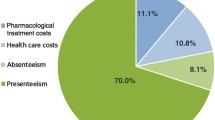Summary
The validity and responsiveness of allergy-specific questions in the format of the Work Productivity and Activity Impairment (WPAI) questionnaire were tested, and the work, activity and classroom impairment of allergic rhinitis patients with moderate to severe allergy symptoms were described. Allergy-specific WPAI (WPAI-AS) instruments were completed at baseline and at week 1 and week 2 by patients in 2 multicentre, double-blind, randomised placebo-controlled clinical trials of antihistamines: terfenadine (work/activity impairment; n = 422) or fexofenadine (MDL 16,455A) [classroom impairment; n = 241]. The validity, responsiveness to clinical change, and reproducibility in the absence of clinical change of the WPAI-AS were measured independently by symptom severity scores. Allergy symptoms were associated with impairment at work, at other regular activities, and in the classroom. The studies established the discriminative and evaluative validity, reproducibility and responsiveness of WPAI-AS measures of work impairment, overall work impairment, activity impairment and classroom impairment secondary to allergy symptoms, but not of work or classroom time missed. To detect a 5% difference in impairment, with 80% power and 5% type I error for a 2-sided hypothesis test (change from baseline to weeks 1 and 2 combined) would require 201 patients/treatment group (overall work impairment), and 192 patients/treatment group (overall classroom impairment).
These results validate the WPAI-AS as tools in quality-of-life analysis of allergic rhinitis and provide data for selecting an adequate sample size to differentiate interventions in controlled studies measuring changes in work, activity and classroom impairment secondary to allergic rhinitis symptoms.
Similar content being viewed by others
References
Meitzer EO. An overview of current pharmacotherapy in perennial rhinitis. J Allergy Clin Immunol 1995; 5 (Pt 2): 1097–110
US Department of Health, Education and Welfare (NIH). National Institute of Allergy and Infectious Diseases (NIAID), Task Force Report, Asthma and the other allergic diseases. Washington, D.C.: 1979 (NIH) Publication No. 79-387
Tarnasky PR, Vanarsdel PP. Antihistamine therapy in allergic rhinitis. J Fam Pract 1990; 30(1): 71–80
McMenamin P. Costs of hay fever in the United States in 1990. Ann Allergy 1994; 73(1): 35–9
Meitzer E. Antihistamine- and decongestant-induced performance decrements. J Occup Med 1990; 32(4): 327–34
Meitzer E. Comparative safety of H1 antihistamines. Ann Allergy 1991; 67: 625–33
Reilly MC, Zbrozek AS, Dukes EM. The validity and reproducibility of a work productivity and activity impairment instrument. PharmacoEconomics 1993; 4(5): 353–65
Guyatt GH, Reeny DH, Patrick DL. Measuring health-related quality of life. Ann Intern Med 1993; 118: 622–9
Guyatt GH, Walter S, Norman G. Measuring change over time: assessing the usefulness of evaluative instruments. J Chronic Dis 1987; 4: 171–8
Guyatt GH, Deyo RA, Charlson M, et al. Responsiveness and validity in health status measurement: a clarification. J Clin Epidemiol 1987; 42: 403–8
Author information
Authors and Affiliations
Rights and permissions
About this article
Cite this article
Reilly, M.C., Tanner, A. & Meltzer, E.O. Work, Classroom and Activity Impairment Instruments. Clin. Drug Invest. 11, 278–288 (1996). https://doi.org/10.2165/00044011-199611050-00004
Published:
Issue Date:
DOI: https://doi.org/10.2165/00044011-199611050-00004




